Shrinkage Reducing Admixture: AQUAGUARD™ TD-200 Shrinkage reducing admixture
- Main Applications
Shrinkage reducing admixture (SRA) for mortar and concrete
- Applications
Basic Information
| Appearance | Colorless-to-pale yellow, transparent liquid |
|---|---|
| Density (g/cm³) | 1.092~1.127 |
| Viscosity (20℃) (mPa・s) | 50 – 200 |
| Total Alkali Quantity (%) | ≦0.05 |
| Chloride Ion Content (%) | ≦0.01 |
| Packing | Can (20 kg), Drum (210 kg), IBC (1,100 kg) |
Features and Properties (Patented)
- Substantially reduces drying shrinkage in concrete
- Easy to create concrete with excellent resistance to freezing and thawing
- Minimal effect on air content and fluidity, with hardly any contamination effect
- Minimal reduction of compression strength, with the same quality as ordinary concrete
- Minimal change in the properties of ordinary and fresh concrete, and in the workability of concrete
- Can be used with expansive additives to create concrete with almost no drying shrinkage
- Non-hazardous material that easily dissolves in water for excellent handling
Mechanisms (Difference with General Shrinkage Reducing Admixture)
- AQUAGUARD™ TD-200: Reduces drying shrinkage in concrete using Nippon Shokubai’s proprietary technology that uses a water retention effect to inhibit water evaporation from the capillaries in concrete. Also, it has minimal effect on air control admixtures (AE admixture and defoamer) due to its low surface-activating action.
- General shrinkage reducing admixture: Reduces drying shrinkage by using a surface-activating action to reduce the surface tension of water inside the capillaries, and reducing the capillary tension that occurs during drying.
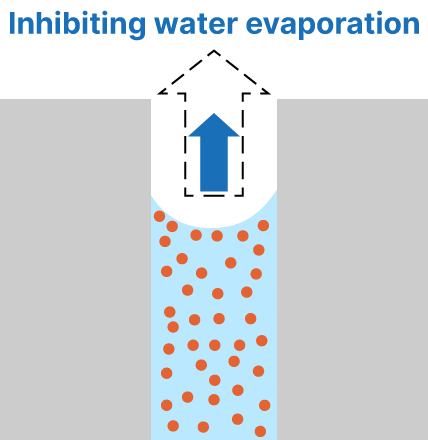
(Reduces the amount of water evaporation from capillaries)
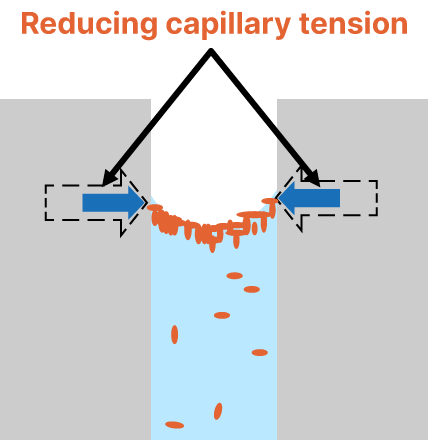
(Reduces capillary tension)
Usage Amount and Method
- The standard usage amount of AQUAGUARD™ TD-200 is 7.5 – 25 kg/m³ for concrete. When determining the usage amount, it is recommended to conduct repeated trials in advance after taking into consideration the required shrinkage reduction performance, mixture and materials to be used, etc.
- Please use AQUAGUARD™ TD-200 as a part of the unit water content.
- AQUAGUARD™ TD-200 can be added into a concrete mixing plant, or as added later into a truck agitator.
Details of Functions
Concrete Properties
(1)Concrete Mixture
| Concrete Mixture | Admixture (kg/m³) | Air Content (%) | |||||||
|---|---|---|---|---|---|---|---|---|---|
| W/C (%) | s/a (%) | Unit Amount (kg/m³) | Water Reducer | AQUAGUARD™ TD-200 | |||||
| C | W and Admixture | S | G | ||||||
| AQUAGUARD™ TD-200 Added (A) | 55 | 48.6 | 309 | 170 | 888 | 939 | 2.2 | 9.6 | 5.8 |
| AQUAGUARD™ TD-200 Added (B) | 11.5 | 5.3 | |||||||
| AQUAGUARD™ TD-200 Added (C) | 19.2 | 4.6 | |||||||
| Without AQUAGUARD™ TD-200 (Plain) | 2.9 | - | 5.1 | ||||||
Fine aggregate: Land sand (Density in saturated surface-dry condition: 2.57 g/cm³)
Coarse aggregate: Crushed hard sand stone (Density in saturated surface-dry condition: 2.65 g/cm³)
(2) Drying Shrinkage Reduction
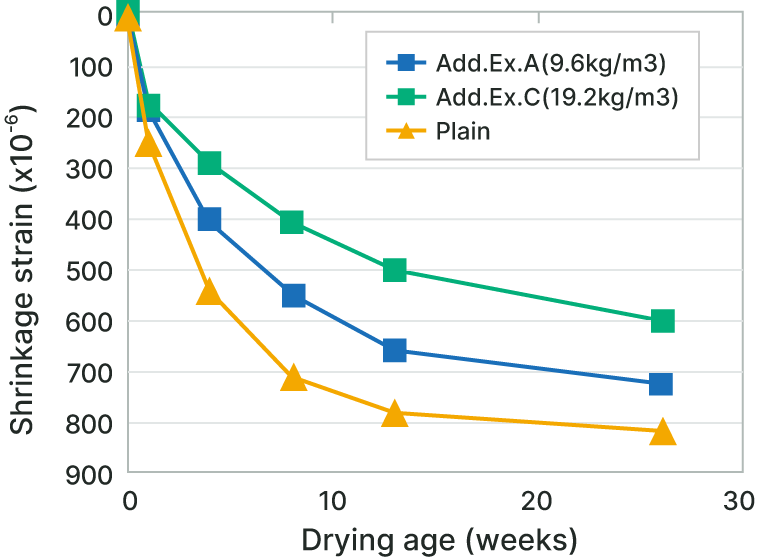
(3) Freezing and Thawing Resistance
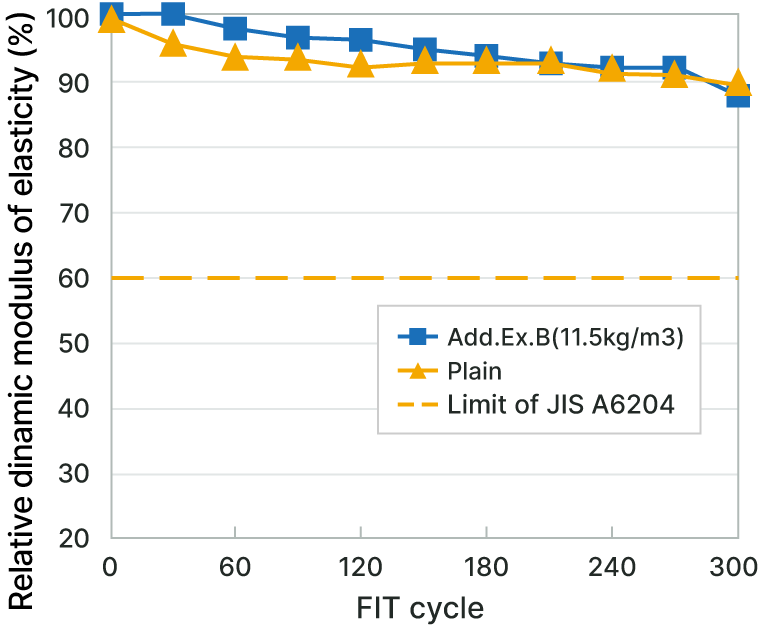
(4) Compression Strength
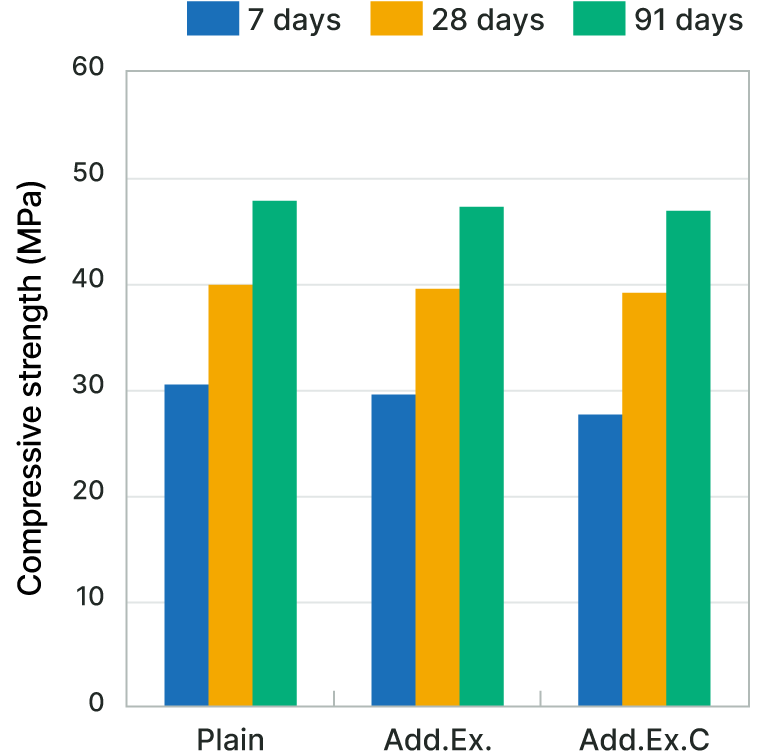
* The values in the table are representative values, and are not guaranteed in any way.
Examples of Construction
Conditions
- Construction method: AQUAGUARD™ is used in adjacent points of the concrete, with placement of the unused concrete
- Concrete mixture: Water/Cement (W/C) ratio of 53% (unit water content 183 kg/m³), Fine aggregate ratio of 43.9%
- AQUAGUARD™ usage amount: 20 kg/m³
- Elapsed days: 5 years
Images of evaluation
AQUAGUARD™ added
(hardly any cracks)
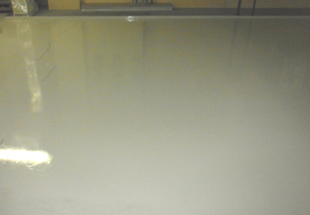
Without AQUAGUARD™
(several fine cracks)
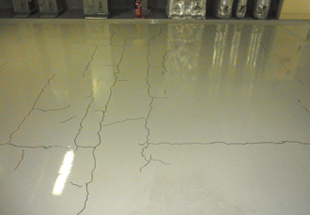
* The cracks on the images have been highlighted. These cracks do not affect the building’s durability.
Precautions
- Please read the Nippon Shokubai Safety Data Sheet (SDS) before storing, using, and handling this product.
- Please note that the contents in this website may be changed without prior notice.
- Please be aware of the intellectual property rights related to third-party usage, usage methods, etc. when using the Nippon Shokubai product(s) listed on this website page. The Company does not take any responsibility whatsoever for any issues that may arise in relation to these intellectual property rights.